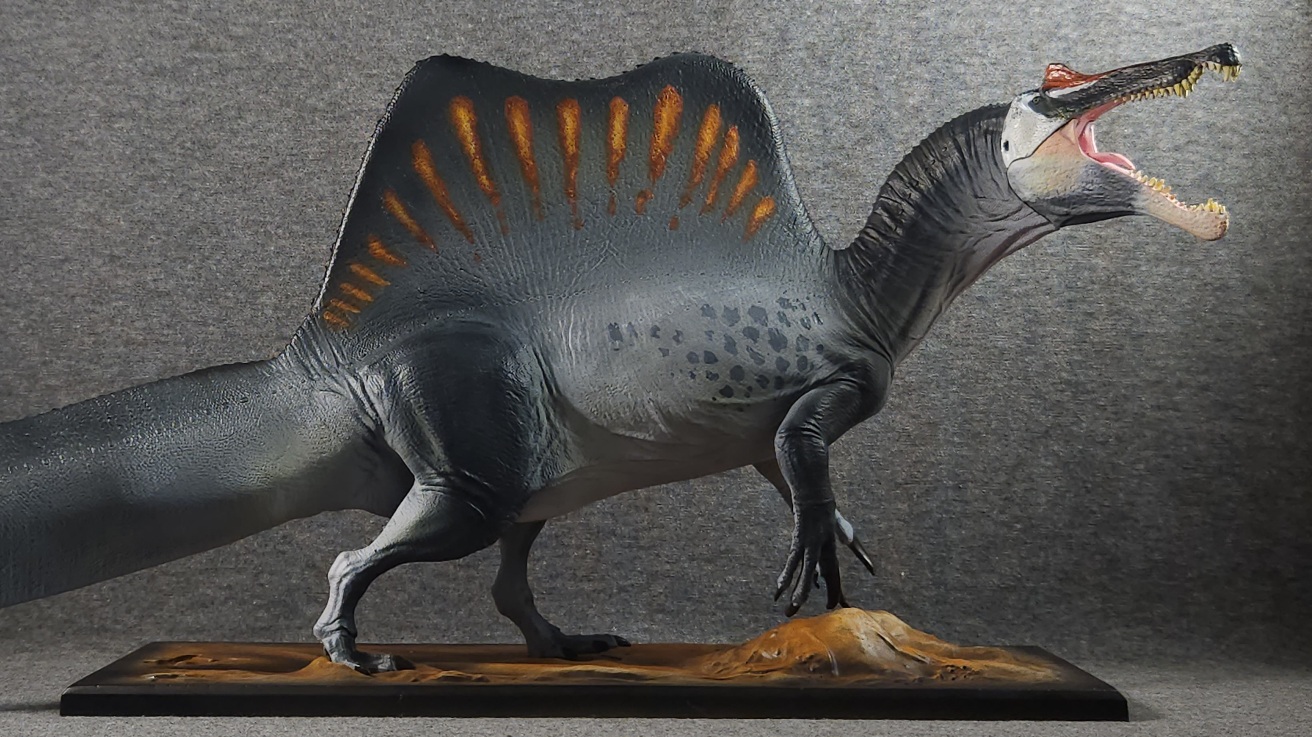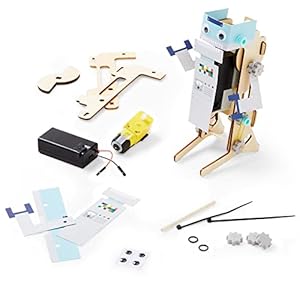
Dawn breaks across the Egyptian marsh. Rays of sunlight begin piercing the treeline, and Ramses stirs as the warmth of the rays tickle the arch of his sail, working their way down his flanks. His six-foot long, toothy jaws open wide in a yawn, and he begins stretching his muscles, readying his body for a new day of activity. Ramses raises himself of the ground into bipedal posture, and begins walking the short distance from his sleeping tree to the open riverbank; his hind limbs appear diminutive, but they bear the weight of his lengthy form with surprising grace. His tall, narrow tail sweeps behind him, counterbalancing his deep chest and long neck. Ramses opens his jaws again, this time to announce his presence. A growling *HONK* like a seven-ton goose reverberates across the waters; this stretch of the river belongs to him, and any visitors must pass his approval. The pharaoh is awake, and a new day of hunting along the rivers begins.

Just a little more than three years to the day since the campaign’s initial launch, a massive box with a special item treasured inside was delivered to my doorstop, courtesy of The Mesozoic Life Project. The item in question was the highly-anticipated scientific replica of “Ramses”, the Spinosaurus aegypticus, a mascot of sorts for a multimedia project dedicated to coverage of unique prehistoric biomes, from the smallest obscure fauna to the iconic saurian superstars of the ecosystem – shades of Walking with Dinosaurs, Age of Reptiles, the currently-ongoing Forgotten Bloodlines series, and a number of other docu-drama titles which have graced paleontology pop-culture. Ramses represented what was to be the first physically realized product out of the project. Although the first campaign failed to reach its goal, the second campaign met with success in June of 2022; despite numerous delays in production, the model was finally completed almost exactly two years later. In late summer of 2024, Ramses began arriving at last to the doorstops of backers around the world, concluding the first chapter of a hard-earned saga and delivering a collective, albeit prolonged, victory for the indie paleo-media sphere and its fans.

Conception of Ramses and the Mesozoic Life Project began in 2019, led by content creator Kevin Miguel Elias (who goes by Blayken on social media), with a team that included notable artists such as Raul Ramos (concept art), Cheung Chung Tat (color scheme), and Jacob Baardse (3D modeling). As the overall project evolved, so did the design for Ramses, with the reveal of new discoveries in 2020 requiring revisions to the already unusual-looking theropod. Although Blayken was working with experienced artists and professional scientists – including Roberto Diaz Sibaja, Elena Cuesta Fidalgo and AgustÍn Martinelli – Ramses would be the first time this independent team would deliver a physical model for market release. The range of quality available in the dinosaur-collecting hobby has expanded spectacularly in the last decade, which put Ramses in a tricky place for expectations. How would this high-end replica from an “amateur” team of model-makers compare to similar products already available from the hobby’s industry giants? Would such a comparison be fair at all?



With Ramses finally arriving in my own hands, I’ve been working to answer the above questions for a while now. Regrettably, it’s taken much longer than I intended to gather and evaluate all the information I needed, but those questions on what Mesozoic Life’s team could accomplish are still well worth an answer. It’s also worth noting that, in the time it’s taken me to compile this review, the next stage of the Mesozoic Life project has gone underway: a fully-animated pilot short titled River of Giants, which launched as a Kickstarter campaign May 14, 2025 and successfully reached its main funding goal by the 22nd, well before the campaign’s deadline of June 14. After more than five years of development, facing numerous hurdles and challenges, the Mesozoic Life Project is finally finding its stride and coming fully to life. With all that history in mind, let’s sit down get started looking at Ramses, shall we?


Ramses comes packaged in a… Well, it’s not exactly a box, but a sizable black Styrofoam block measuring a hefty 54.5 x 27 x 13.5 cm (21.5 x 10.5 x 5.25 in), with a cardboard sleeve for protection and presentation. The block holds the figure snugly in place, with some additional Styrofoam pieces covering from the front. The sleeve displays artwork of Ramses on the front, with prototype photos on top and an informational blurb about Spinosaurus on the bottom. The back of the sleeve is just blank, solid black. The package feels very “premium on a budget”, if that makes any sense; the project team clearly put effort into the presentation, but were likely forced to cut corners to keep costs manageable. It’s perfectly serviceable at its main purpose, which is keeping Ramses secure when in storage. The biggest challenge might just be figuring out where to store such a large “box”; but that would be inevitable regardless of the package. Ramses is plenty large as a figurine, demanding plenty of space once he enters his new domain.

Ramses himself measures a whopping 50 cm/19.75 in long – which is before factoring in the curvature of his neck and tail – and 17 cm (6.75 in) tall from sail to toe, without the base. At this size, Ramses could represent a modest 12.6-meter individual at 1:25 scale, a large 15-meter individual at 1:30 scale, or a colossal 17.5-meter individual at 1:35 scale. We don’t have any fossils supporting the third option yet, but it might be within the realm of possibility (according to a recent case study on theropod size). In any case, collectors familiar with Safari, Collecta, PNSO, etc will find Ramses is easily bigger than most other theropod figurines available, and even rivaling some of the sauropods out there. Posed in a mostly neutral, traditional walking pose with the mouth agape in a roar, Ramses doesn’t need an especially dynamic pose to maintain a commanding presence on the shelf.

Ramses does need some assistance in posing, however; he is accompanied by one accessory in the form of a hard plastic display base, which is necessary for Ramses to stand with. Measuring 27 cm (10.75 in) long by 10 cm (4 in) wide, and roughly 7 mm high along the edges, the base emulates a muddy river bed or bank, with rusty orange mud flats and an erratic surface of rocks, mounds, and ripples. A pair of footprints are molded into the base for Ramses to fit his feet in, with a peg rising from the left print for extra stability. Although the material feels kind of flimsy to me, the base appears sturdy and looks very professional; I can easily envision the model and mount being displayed in a Museum window box. Regrettably, Ramses’s feet don’t quite fit snugly in the footprints, even after attempts to reshape the feet with hot water treatment; thankfully that doesn’t impede the stability in any noticeable way. Ramses uses the fingers of his right hand as a third balancing point, which lines up with the rocky raised portion of the base. Not everyone might appreciate this design choice, but I’m sure every seasoned collector reading this can appreciate how tricky the task of balancing a toy theropod dinosaur is; even the best companies in the business still can have hit-or-miss records keeping their bipeds stable. The Mesozoic Life team went through numerous iterations trying to fit the sweet spot for Ramses before settling on this compromise. I view it as a subtle nod to the brief quadruped era of Spinosaurus reconstructions we had following the new discoveries published in 2014. The sail-backed dinosaur has seen a lot of changes in the past decade, changes which the project team had to weigh carefully for Ramses’s final reconstruction.




There are currently two major camps of Spinosaurus reconstructions: the “aquatic pursuit” model, based on the findings of Ibrahim et al. 2020, and the “semiaquatic ambush” model, based on Sereno et al. 2022. These two papers and their accompanying skeletal illustrations have inspired numerous other revised takes on the animal’s appearance by a variety of artists since then, each with their own nuances to the dimensions and functionality of the dinosaur’s ever-peculiar-looking anatomy. The design team for Ramses had plenty to work with in deciding where on the Spino-spectrum Ramses would fall. Having spent a lot of time pouring over the published figures and the plastic figurine alike, I can only imagine how exhausting the process of actually MAKING this model had to be! Ramses serves to remind me of how much work and study goes into the science of serious paleoart, commercial or otherwise.

The final design for Ramses appears to take cues from both sides of the Spinosaurus lifestyle debate, hedging some bets and making some compromises to achieve the vision the team felt was suitable. Ramses’s skull is unmistakably spinosaurine in its narrow, gar-like jaws and notched snout, lined with large conical teeth. A precise total of six teeth line each side of the premaxilla, with another thirteen on each maxilla – possibly one too many, but that’s a minor quibble. I do, however, think the snout’s narrowness and shallowness might be a bit exaggerated for this model, as the incline to the deeper jugal bone (the “cheek”/back of the mouth) looks sharper than even most current reconstructions. I’m also unsure of how much binocular vision Spinosaurus would have been capable of, although the forward-facing eyes certainly add to the striking appearance on Ramses. A single half-oval crest protrudes from the top of Ramses’s head between the eyes, and the nostrils and ear holes are defined well. One caveat to the design is that the lower jaw – which is a separate piece from the head – is a little conspicuous with the seam lines from some angles.


Most reconstructions are at least consistent about the skull; it’s the postcranial skeleton (ie, everything else) where Ramses the Spinosaurus gets trickier. The neck of Spinosaurus is thought to be fairly long, at least longer than the animal’s already sizable skull; Ramses’s neck may be conservative in that regard. Ramses’s torso is slightly over twice the length of the skull – measured from the shoulder to the hip socket – which does match up with both the 2020 and 2022 reconstructions, from my own estimates. The actual shape of the torso aligns with the 2022 version, which has a shallower chest cavity that reduces the frontal weight. The tail, meanwhile, also matches closer to the 2022 proportions – its length equal to the torso plus the skull up to the antorbital fenestra – but those rough measurements of mine could be a little off due to the shortened neck.

While the very tip of the tail tapers like in the 2022 skeletal, the neural spines at the base of the tail exhibit a concave shape resembling the 2020 skeletal instead; likewise, the musculature of the tail near the base is narrower underneath, as opposed to the robust cross-sections modeled for the 2022 reconstruction (another key feature in counterbalancing and realigning the animal’s center of gravity in life). The eponymous sail on Ramses’s back is modeled in the M-shape that’s been popular in reconstructions since 2014, instead of the more traditional convex sail that has been making a return more recently. A modest layer of soft tissue covers the sail, smoothing out the surface and blending into the flanks of the body. It’s a far cry from a hump, as some have postulated, but it might still be more tissue than the most recent analyses suggest would have sheathed the spines.

Out of all the surprises Spinosaurus has given us in the past decade, the most controversial is the hind limbs, which are so short some scientists and artists were convinced the remains were a chimera of separate creatures. So far the chimera theory has been debunked, but questions remain about the exact dimensions of the animal’s limbs in adulthood. Thankfully both the 2020 and 2022 papers seem to be in agreement about size, thanks to how complete the fossils are. Ramses looks to have accurately proportionate legs, with the thigh equal to the pubis and ischium of the hip, and the shin bone about equal in length again. The forearms can touch the ground with their claws, as mentioned before; but this has more to do with what phase of the gait the legs are in. The reduced inner toe also flattens against the ground accurately, and a modest sheet of webbing stretches between each of the larger toes. One production error is present here on the right foot, where there’s a gap in the webbing between the second and third toes.

A lot of modern Spinosaurus designs like to imitate crocodiles in their osteoderm armor and mottled brown-and-green skin patterns. Even without the croc scutes, a lot of Spinos end up being colored brown in some form or other. For Ramses, the creative team decided to do something very different: using two modern-day dinosaurs, the agami heron (Agamia agamio) and the tricolored heron (egretta tricolor), for reference, the team decked out Ramses in a beautiful wash of blues, from deep midnight shades to ashen-white tints. The face is punctuated with stark white markings and a bright red to the crest. The minute eyes, perfectly marked with green irises, are easily lost in these markings; but any would-be enemy would quickly take notice of the bright pink mouth and sharp teeth. There are some discrepancies to note, however, besides a trace of paint slop on a couple of teeth. I mentioned before how the lower jaw is a separately molded piece; it also appears to be separately painted, as the white values don’t quite match the skull, and the throat displays a jarring cutoff from dark to light blue where the jaw piece attaches. I’d be more critical of this error from an established studio like PNSO, but given the nature of this product I’m more willing to let it slide.


Returning to the postcranial color patterns, there are irregular splotches that decorate the ribcage and play on the light/dark values of the coloration nicely. The underneath of the figure is a very light, milky blue, with just a hint of pink mixed in, while the darkest values can be found on the outer limbs, the back of the neck, and the rim of the sail. The sail also features a row of fiery red-and-orange bolts streaking upwards and outwards, intensifying the display qualities of the structure. It’s not a garish touch, and it helps the overall figure pop in color a little more. One note of criticism I will make is that some of the reds and oranges look a bit sloppy in application and blending; but most viewers probably won’t notice unless they’re looking for it. Similarly, along the tail there appear to be several discolored spots amidst the blue, as if one or two coats were applied (or maybe removed) unevenly. This can be a bit more noticeable, depending on the lighting; but once again, the overall quality of the work seems very impressive to my eyes for such a small project. I can only imagine what limitations they might have faced with the production factory on their budget.



It’s been a long road for Ramses, reflective perhaps of the tumultuous history of Spinosaurus itself; but I feel confident in saying the Mesozoic Life Project’s first physical reward has met all of my expectations with flying colors. It’s a magnificent piece that captures all of the weird and wonderful traits that make the dinosaur so fascinating today. The mixture of features between the two vying reconstructions might annoy collectors looking for a “pure” rendition of one reconstruction or another, but I think the model serves a fine representation of this period in time when our understanding of Spinosaurus is still going through an upheaval, with many uncertainties yet to be resolved. Some quibbles can be made about the base or the paint application, but overall this is one of the most impressive dinosaur figurines in my entire collection. Although Ramses was produced as a limited campaign run, new models were designed for this year’s Kickstarter, and I think it’s safe to say we will continue seeing figurines of this quality from the Mesozoic Life team for as long as the project is alive and kicking.






Trending Products










